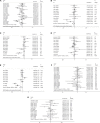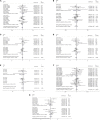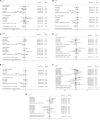Association of Retinol and Carotenoids Content in Diet and Serum With Risk for Colorectal Cancer: A Meta-Analysis
- PMID: 35845801
- PMCID: PMC9280435
- DOI: 10.3389/fnut.2022.918777
Association of Retinol and Carotenoids Content in Diet and Serum With Risk for Colorectal Cancer: A Meta-Analysis
Abstract
Background: Colorectal cancer (CRC) risk is linked to serum and dietary retinol and carotenoids, according to clinical and epidemiological research. However, the findings are not consistent. As a result, we did this meta-analysis to determine the link between them.
Methods: From 2000 through 2022, the PubMed, Web of Science, and Embase databases, as well as pertinent article references, were searched and filtered based on inclusion and exclusion criteria and literature quality ratings. High and low intake were used as controls, and OR (odds ratio) or RR (relative risk) and 95% confidence interval were extracted. The extracted data were plotted and analyzed using Stata12.0 software.
Results: A total of 22 relevant studies were included, including 18 studies related to diet and 4 studies related to serum. For high and low intake or concentration controls, the pooled OR was as follows: β-carotene (OR = 0.89, 95% CI: 0.78-1.03), α-carotene (OR = 0.87, 95% CI: 0.72-1.03), lycopene (OR = 0.93, 95% CI: 0.81-1.07), lutein/zeaxanthin (OR = 0.96, 95% CI: 0.87-1.07), β-cryptoxanthin (OR = 0.70, 95% CI: 0.48-1.01), total carotenoids (OR = 0.97, 95% CI: 0.81-1.15), retinol (OR = 0.99, 95% CI: 0.89-1.10), serum carotenoids (OR = 0.73, 95% CI: 0.58-0.93), serum retinol (OR = 0.62, 95% CI: 0.26-1.49). Subgroup analysis was performed according to tumor type, study type and sex.
Conclusion: Total carotenoid intake and Lutein/Zeaxanthin intake were not associated with CRC risk. High β-carotene, α-carotene, lycopene, and β-cryptoxanthin all tended to reduce CRC risk. Serum carotenoid concentrations were significantly inversely associated with CRC risk.
Keywords: carotenoids; colorectal cancer; meta-analysis; retinol; risk.
Copyright © 2022 Han, Zhao, Zhang, Jiao, Wang, Wang and Cai.
Conflict of interest statement
The authors declare that the research was conducted in the absence of any commercial or financial relationships that could be construed as a potential conflict of interest.
Figures








Similar articles
-
Carotenoid Intake and Circulating Carotenoids Are Inversely Associated with the Risk of Bladder Cancer: A Dose-Response Meta-analysis.Adv Nutr. 2020 May 1;11(3):630-643. doi: 10.1093/advances/nmz120. Adv Nutr. 2020. PMID: 31800007 Free PMC article.
-
A systematic review of dietary and circulating carotenoids and liver disease.Food Funct. 2024 Sep 30;15(19):9813-9832. doi: 10.1039/d4fo03082f. Food Funct. 2024. PMID: 39229651
-
Not all carotenoids can reduce the risk of gastric cancer: a systematic review with meta-analysis.BMC Gastroenterol. 2024 Jan 29;24(1):51. doi: 10.1186/s12876-024-03139-5. BMC Gastroenterol. 2024. PMID: 38287248 Free PMC article.
-
Specific serum carotenoids are inversely associated with breast cancer risk among Chinese women: a case-control study.Br J Nutr. 2016 Jan 14;115(1):129-37. doi: 10.1017/S000711451500416X. Epub 2015 Oct 20. Br J Nutr. 2016. PMID: 26482064
-
Carotenoids and breast cancer risk: a meta-analysis and meta-regression.Breast Cancer Res Treat. 2012 Jan;131(1):239-53. doi: 10.1007/s10549-011-1723-8. Epub 2011 Sep 7. Breast Cancer Res Treat. 2012. PMID: 21901390
Cited by
-
Unveiling the atlas of associations between 1,400 plasma metabolites and 24 tumors: Mendelian randomization analyses.Transl Cancer Res. 2024 Sep 30;13(9):4938-4956. doi: 10.21037/tcr-24-359. Epub 2024 Sep 9. Transl Cancer Res. 2024. PMID: 39430859 Free PMC article.
-
Constructing a novel signature and predicting the immune landscape of colon cancer using N6-methylandenosine-related lncRNAs.Front Genet. 2023 Jun 16;14:906346. doi: 10.3389/fgene.2023.906346. eCollection 2023. Front Genet. 2023. PMID: 37396046 Free PMC article.
-
Colorectal Cancer: Current and Future Therapeutic Approaches and Related Technologies Addressing Multidrug Strategies Against Multiple Level Resistance Mechanisms.Int J Mol Sci. 2025 Feb 4;26(3):1313. doi: 10.3390/ijms26031313. Int J Mol Sci. 2025. PMID: 39941081 Free PMC article. Review.
-
Bioactivity and Bioavailability of Carotenoids Applied in Human Health: Technological Advances and Innovation.Int J Mol Sci. 2024 Jul 11;25(14):7603. doi: 10.3390/ijms25147603. Int J Mol Sci. 2024. PMID: 39062844 Free PMC article. Review.
-
Cancer Prevention and Treatment Based on Lifestyles.Cancer Treat Res. 2024;191:245-279. doi: 10.1007/978-3-031-55622-7_10. Cancer Treat Res. 2024. PMID: 39133411 Review.
References
Publication types
LinkOut - more resources
Full Text Sources
Research Materials

